Wednesday, April 13 2016
Did we see the Bulls blast out to the upside today ?
- New run to at least to 212.0 or 214.0 ???
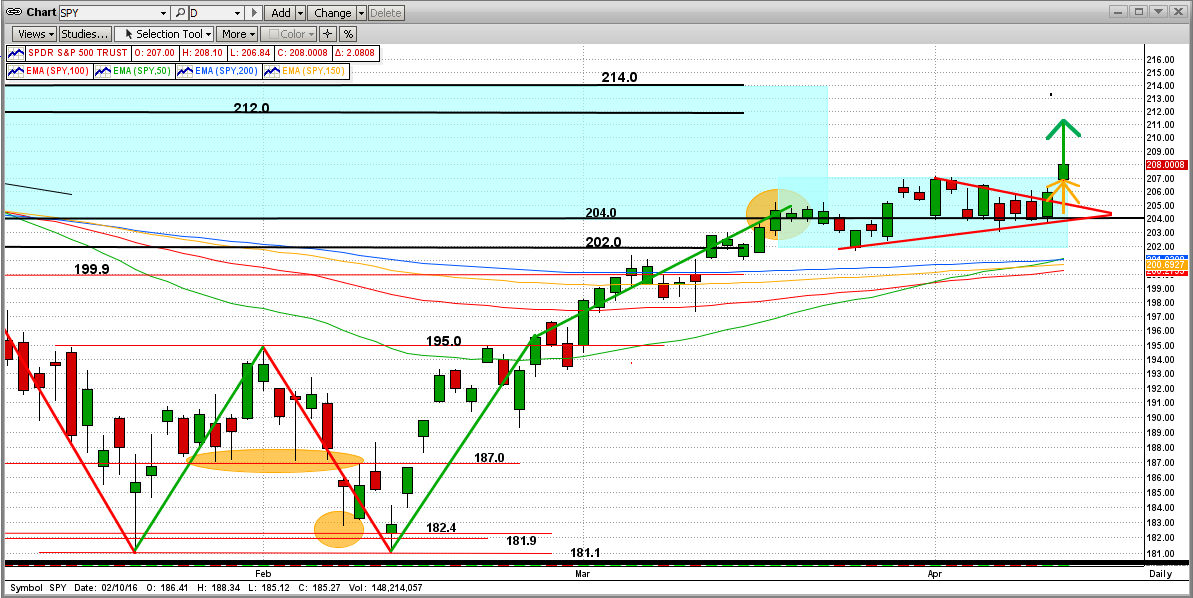
Monday, April 04 2016
Where do we go from here?
The SPY is sitting close to 204, up from about 181. The Bears want to push the SPY back down to 181, but the Bulls want it to continue up to the all-time-high resistance level at 214. When the SPY hit 204, it was like hitting a triple-reinforced brick wall (with lots of waffling around since then). "The Battle of 204" will turn out to be quite a battle.
Lots of people are simply peeking over the fence (watching) to see what might happen next, but MIPS is "in the gears" analyzing (calculating) what is most likely to happen next. I'm betting on MIPS !!!
PEEKING...

MIPS'ing...
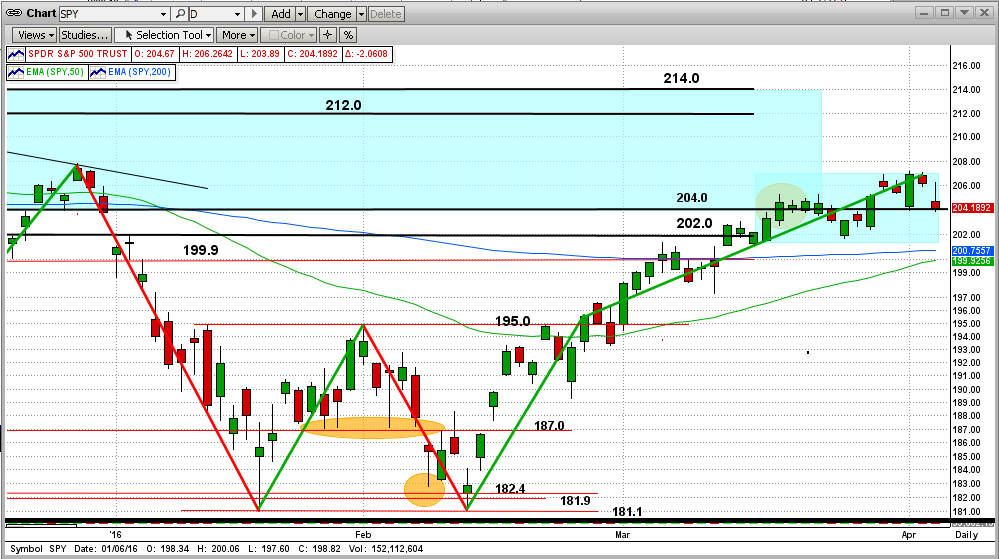
Sunday, April 03 2016
Rightfully so, many MIPS members are concerned about curve fitting, data mining, etc., in timing models on the market today (and, or course, in the MIPS models themselves). I can tell you point blank that we do not curve fit in the development of the MIPS models. I can also say with a high degree of certainly that any engineer with an advanced degree from a good school who has written software for control systems (say for nuclear power plants, space rockets, fighter jets, commercial aircraft, etc.), where failure is expensive or disastrous, knows the difference between curve fitting and the development of new algorithms to improve their software's performance.
I say "rightfully so" above, because many (or most) model developers do curve fit in the "development" of their models (if you want to call it "development"). The problem is that "curve fitting" is not really "development". It is merely forcing a bad model to look good using a certain set of data. And yes, done correctly, that model may produce good results after curve fitting with a certain set of data, but will almost certainly fail with any other set of data. I can also tell you that I know several model "developers" that curve fit in some form or fashion in their models, and they don't even know that they are doing so.
In reality, there can be a fine line between:
(1) curve fitting an existing model to perform better or
(2) introducing new algorithms to make a revised model perform better than its predecessor.
Let's see if I can come up with an example of this. In many cases, trying to come up with an example to explain something is more complicated than describing the original.
Allow me to try to explain fixing a fighter jet's control system software to better adhere to the design specs as to how fast the jet should climb in relation to how far back the pilot pulls "the stick". In any decent software of this type, the formula would be based on the physical fact that, because of the curvature of the top of the wing compared to the flat bottom, the air traveling over the top of the wing goes faster than that along the bottom, and hence the air pressure on the top of the wing is lower than that on the bottom. This pressure difference, of course, is what "pushes" the jet up into the lower pressure zone. This is why the wing is designed and built the way it is.
Now, let's say the fighter jet isn't working the way is should and two teams set out to fix it. Team #1 applies curve fitting and team #2 chooses to redesign.
Team #1
Curve fitting in this case could be "developers" tweaking certain parameters in the existing formula to force the jet to climb at a certain rate depending upon the speed of the jet. They may make this one jet perform better, but their "design" will likely fail for all others.
Team #2
Real development in this control system software would be where the design engineers that developed the formulas for how fast the wind over the wing should travel, realize that these formulas were developed for Mach1 speeds, but the current jets travel at Mach3. They also know that, at Mach3, the faster wind speed heats up the air going over the wing more than Mach1, and this hotter air get "lighter" (lower pressure). So, lighter air on the top makes the pressure from the bottom more effective, and the jet moves up faster.
Therefore, rather than one-time random "adjustments" which are also unexplainable from Team #1 (the curve fitters), the "real" design engineers in Team #2 introduced new mathematical algorithms that take the speed of the jet into consideration and adjust accordingly and automatically, and the software then works again at all speeds.
The main difference between these two approaches, of course, is that, when the software controlling of the jet needs to be improved:
Team #1 members "need and use" the raw data to adjust/develop their model, whereas
Team #2 members introduce new mathematical algorithms to closer resemble the performance of the jet itself (and they use the data
only to "prove" that the new algorithms/equations did improve the performance of the jet in the way in which it was designed).
Is this understandable?
Saturday, April 02 2016
GREAT NEWS FOR MIPS MEMBERS !!!
We have spent the last 15 months developing what has turned out to be some of the very best models on the market today. We call this version of our models the "Blaster Series". Even though we added many new algorithms that would make our models better, the main contribution is how we now handle "flat markets" (aka, sideways trading patterns, consolidation patterns, etc.). Call them what you will, but they wreak havoc on all types of timing models; partially because they are "trendless" and partially because these types of markets can change direction so frequently (every few days), that timing models available on the market today usually get whipsawed when trying to follow these patterns.
Therefore, we added new code in our MIPS models to successfully deal with:
(a) low volatility markets that "wiggle" either in a flat or very slow growing/degrading trend (2005),
(b) high volatility markets that shoot up/down in big cycles, and end up where they started (2011),
(c) high volatility markets that trade in a "very tight trading range" of plus/minus 3-5% and change
direction very frequently (like every 4-7 days, as in the first 8 months of 2015).
The results are a developer's dream:
Our tests of the new models show that, compared to the performance when we started developing this new series,
1) the CAGR of the Blaster models are 30-50% higher,
2) the Maximum Drawdowns have been reduced by about 35%, and
3) the average number of annual trades are about the same as, or a little less than, before.
Nomenclature:
Below are the names that we will use going forward to distinguish between the new MIPS "Blaster Series" models and the names of the prior models from which they came.
Pre-Blaster Models Blaster Models
MIPS1 No new model
MIPS2 MIPS22
MIPS3 MIPS33
MIPS4 MIPS44
MIPS/Nitro MIPS/Nitro5
Blaster Performance:
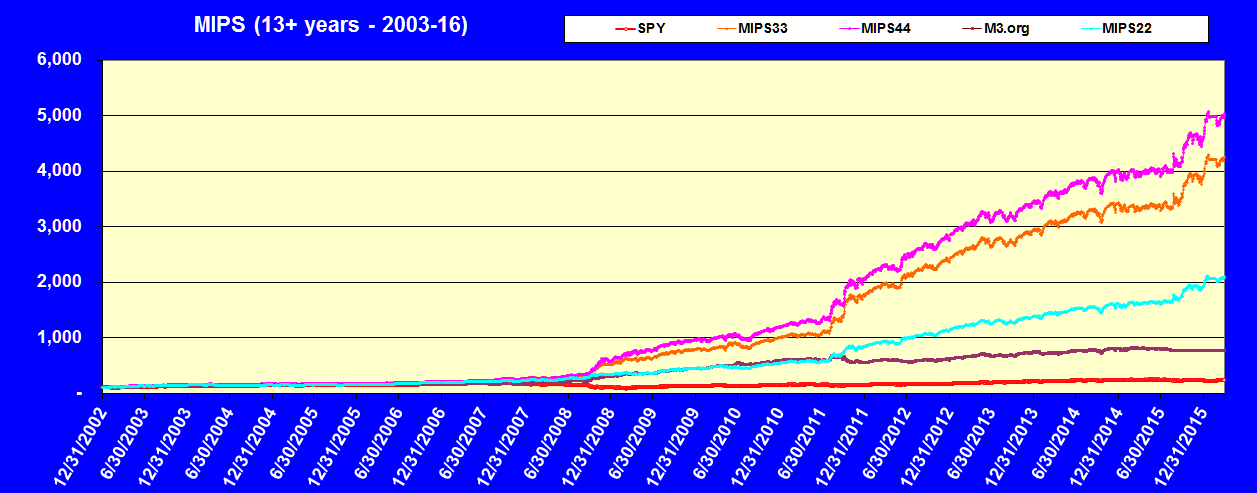
Tuesday, March 22 2016
Many of our MIPS followers (including me) are asking if we will see new highs on the S&P 500 in the near future. We believe there is a good chance of that happening, but we are at a very critial point now.
As you can see in the graph below, the SPY broke through the top of an obvious double bottom at 195.0 (SP500 1950) in early March 2016, and then climbed rapidly to the bottom of the 12-month flat channel from 2015 at 204.0 (SP500 2040). The "area" between SPY 204.0 and 214.0 is what we have been calling "No Man's Land". The SPY broke through 204.0 with force (orange elispe), and has "stagnated" close to there for the last 3 trading days. It is very bullish that the SPY has been able to close above 204.0 every day after either opening or dropping below 204.0 intraday. Good "bounce-backs" for the bulls !!![Looks like someone hanging on to the top of a fence for their life, and it may be so for some of their investing lives.]
It will be very difficult for the bulls to push the SPY all of the way through "no man's land", up to strong resistance levels at 212.0 and 214.0 (SP500 2120 and 2140). The SPY all time high is at 213.5 (SP500 2135). And, of course, it will be even harder for the bulls to push the SPY through that level. Even if that does happen, none of this is really good for us unless the SPY keeps going up from there or we get out before the fall back. Read on...

Alternate:
If the bulls cannot push through SPY 213.5, we may be back to the topping process and the possibility of a big drop from near the all-time high. See below.
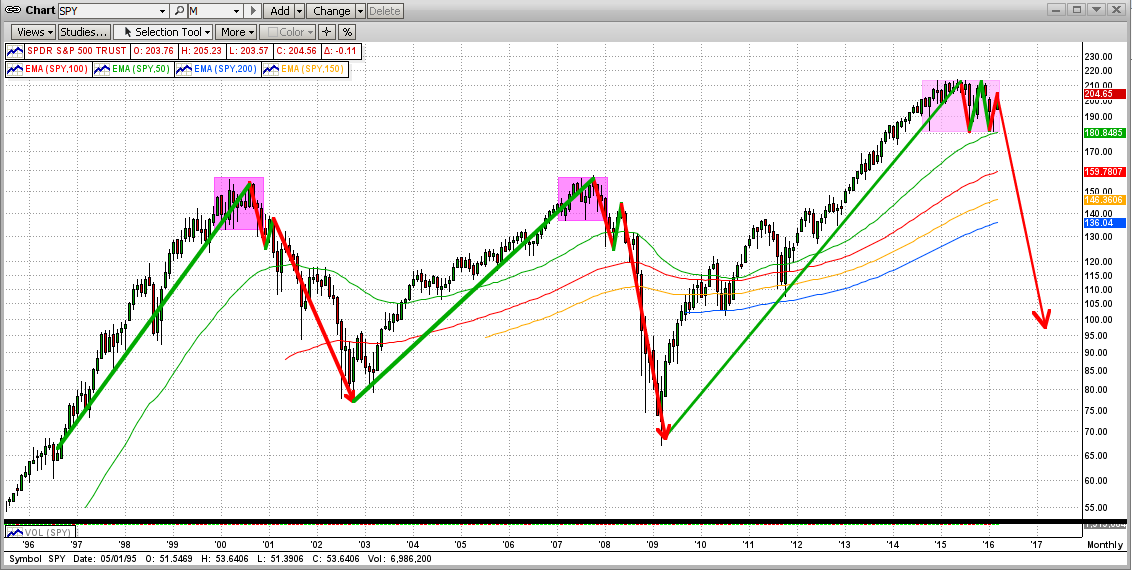
We will wait for MIPS to tell us how to trade this market...
Sunday, March 13 2016
With the recent price action in the stock market, one may ask if we are in a "New Bull Run" or a "Bear Market Rally" ?
If we look at the S&P 500 Index (or the SPY) over the last 12 months, this market does not look like it is going anywhere, except maybe up and down over-and-over again. Or, maybe even down, if not for the recent rally. The question is, "is this recent rally for real" or just a natural kick-back from a big drop (bear market rally)?
But, as active investors, we do not have the luxury to sit back and "only" analyze the market activity over the last year. We need to know where this market is going from here, now !!!
Read on...
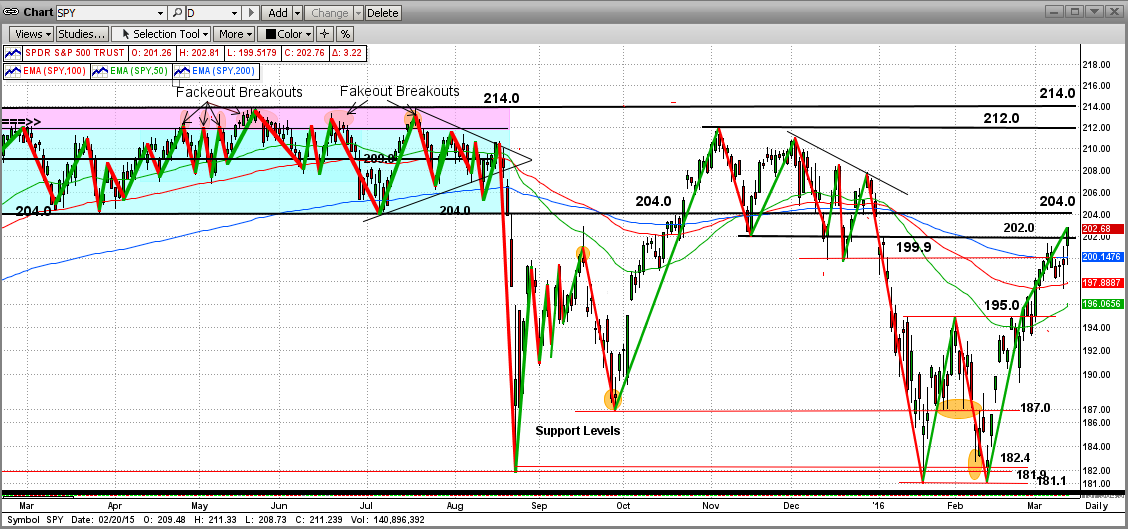
In the graph below, you can see that after several drops and kick-backs, the SPY hit and bounced off of its strong support at the SPY level of 181.0 (SP500 1810) in mid-February of 2016.
Even though there were a few other hurdles along the way up, we (and everyone else on the planet) knew that the SPY would face its toughest upside resistance at the top of the double bottom pattern at 195.0 (SP500 1950). Needless to say now, the SPY broke through 195.0 with force at the beginning of Mar'16. That was really bullish !!!
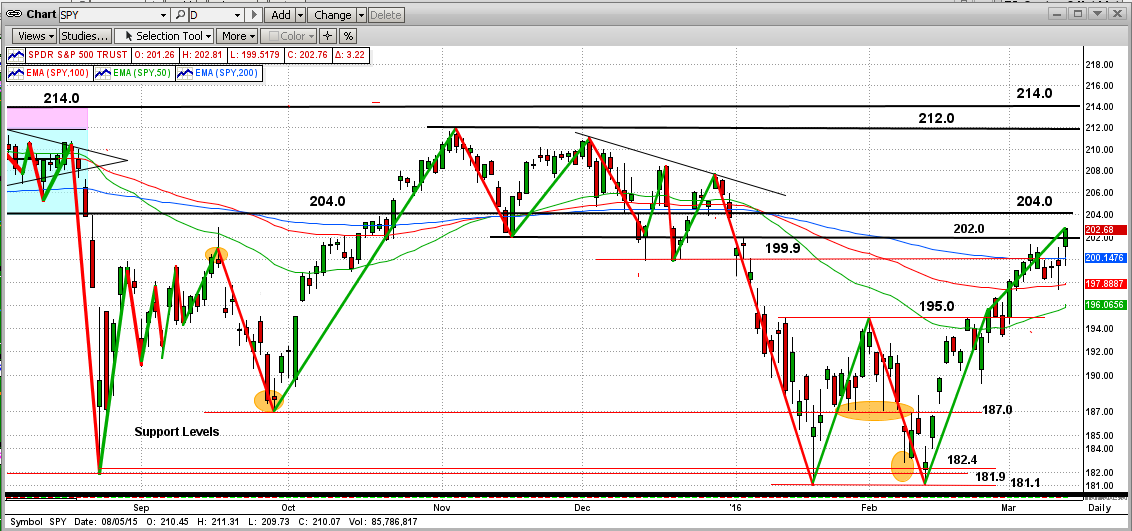
So, where does this leave us? Since its breakout at 195.0 (SP500 1950), the SPY has managed to break through 202.0 and head for the nasty tight-trading "channel" where it "lived" for all of the first 8 months of 2015. This "channel" is between SPY 204.0 and 214.0 (SP500 2040-2140). If the SP500 actually hits 2140 (SPY 214.0), it will be at an all-time high, and then the sky is the limit.
But, since there are no guarantees, this market could easily fail in its attempt to reach a new all-time high, and head back down and turn into a real "market crash". Please understand that "this risk is not gone". We will leave that analysis up to MIPS. Stay tuned...
Monday, February 22 2016
Today, and over the last two months, the market (SPY) has formed an almost perfect "W" trading pattern (Google "M and W" trading patterns for more info). Some analysts call the M patterns double tops and W patterns double bottoms.
I agree with that at times, but not most of the time. Most times, I have seen the market break out of the M&W pattern in the direction that it went in (i.e., if it formed the pattern on a down trend, it usually came out to the downside, and vice versa.)
Also, we have seen these patterns repeat themselves for months, in which case I look at them as pure "sideways trading patterns" or "consolidation patterns" (up and down over-and-over in a tight range, as the market did for the first 8 months of this year). These are dangerous patterns and MIPS now has new algorithms to handle this or run to the sidelines and wait it out (i.e., minimize whipsaw).
But, now the SPY has formed a new W pattern and this time its anybody's guess. See the graph immediately below. The W pattern hit the bottom of its pattern twice at exactly 181.1 (1811 on the S&P 500 index) and got kicked back up both times by the bulls; and recently it hit the top of the pattern at 195.0 (1950 on the S&P 500) for the 2nd time and got slapped back below a little by the bears (for now). So far, this spells strong downside support at 181.1 and possibly strong upside resistance at 195.0. Read on below ...
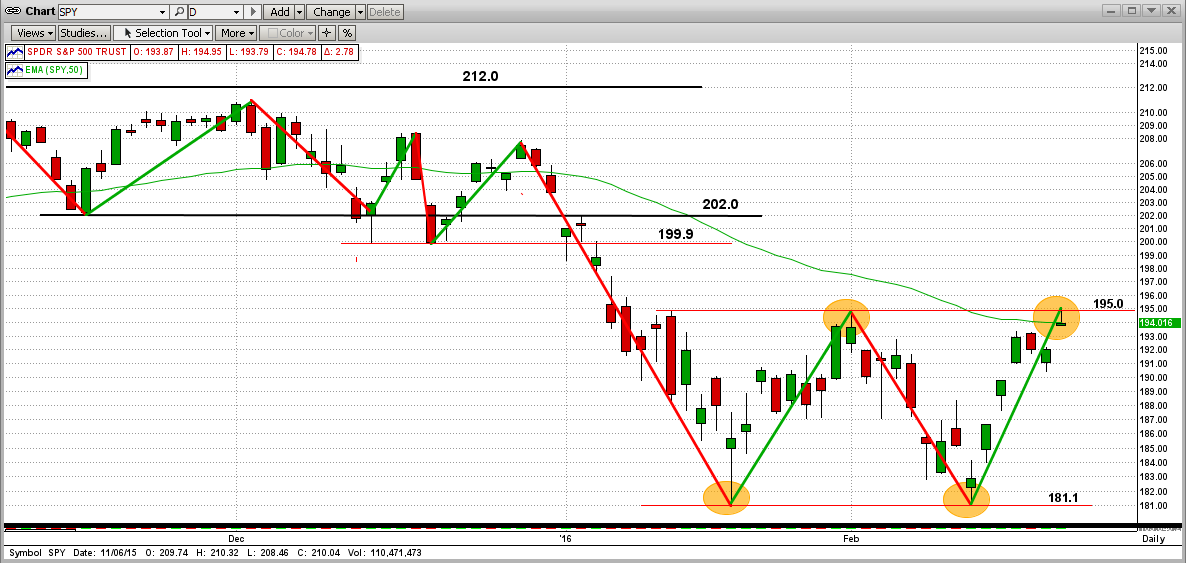
The next 2-3 trading days are crucial !!!
From here, if the SPY moves above 195.0 with force (and/or stays above it for a few days), we can look for the SPY to rally up to the next strong resistant levels at 202 or even 212. But, if it fails to break (and hold) above 195.0, we think the market (SPY) will drop back to test its support level at 181.1 (1811 on the S&P500). Then, if it breaks below 181.1, there is no strong support until way, way down (like in a real "crash"). My guess is that we may have a small rally from here, followed by a break to the downside below 181.1 sometime in the next 3-6 months. Follow MIPS, not me !
We are trusting MIPS to tell us what to do next, and I believe that MIPS will decide that shortly.
Stay tuned...
Monday, February 08 2016
Please review our previous email below from 1/27/2016 (Beware the Bear !!!), or you may have trouble understanding this one.
In the previous email, we included a:
#1 daily graph,
#2 weekly graph, and
#3 monthly graph
in order to show how the SPY has been breaking all support to the downside starting at a high of 214.0 in 2015 (approx 2140 on the S&P 500). Today, the SPY broke to the downside through a very important support level at 187.0 that it had touched, and bounced back up from, 4 times in the last 8 trading days !!!
Today's breakthrough started with force (S&P500 down 50 points), but the SPY bounced back up after touching the next very important support level at about 182.4 (not a good sign for the Bears). In fact, this could be interpreted as a "one-day key reversal"; where the SPY could change direction and head back up from here for a while. Read on...
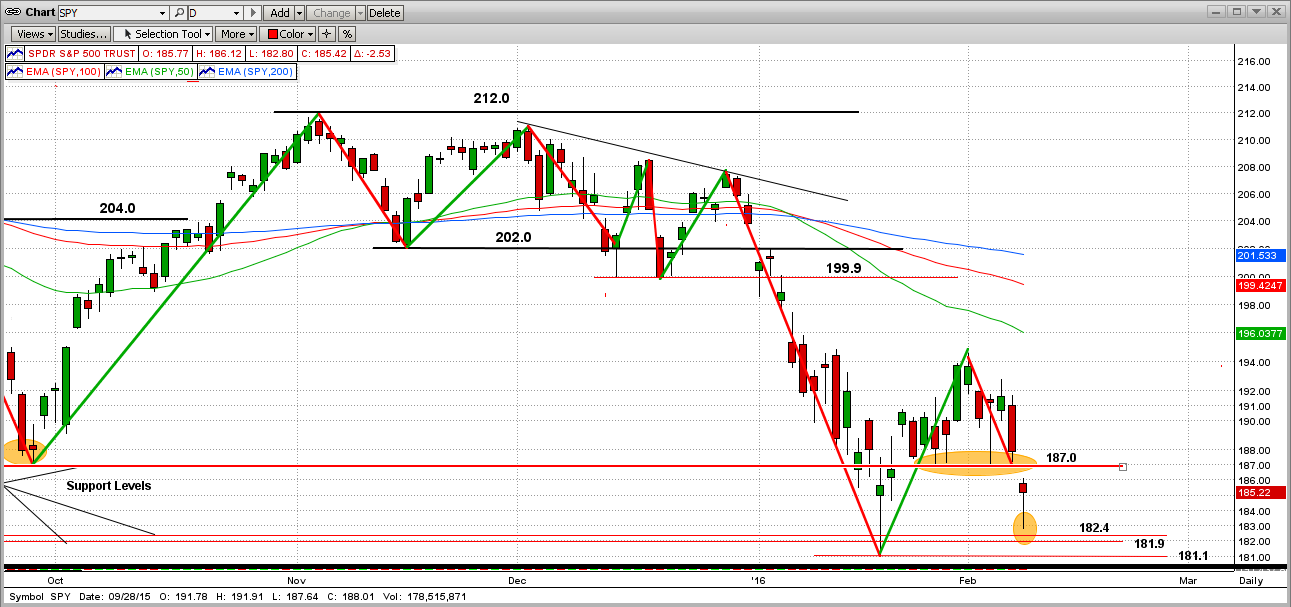
Or, maybe the bears will get aggressive and charge ("test") the last strong support level at 181.1. If the SPY does break below 181.1 with force (after 4 tries now) and stays below for a few days, this could be the start of the big drop we have been keeping you aware of. This, of course, would not be pretty for most investors, but MIPS is on the verge of a going short now, and would quickly identify and short the big drop. If this does happen, the graph below shows what the SPY could look like over the next few weeks/months.
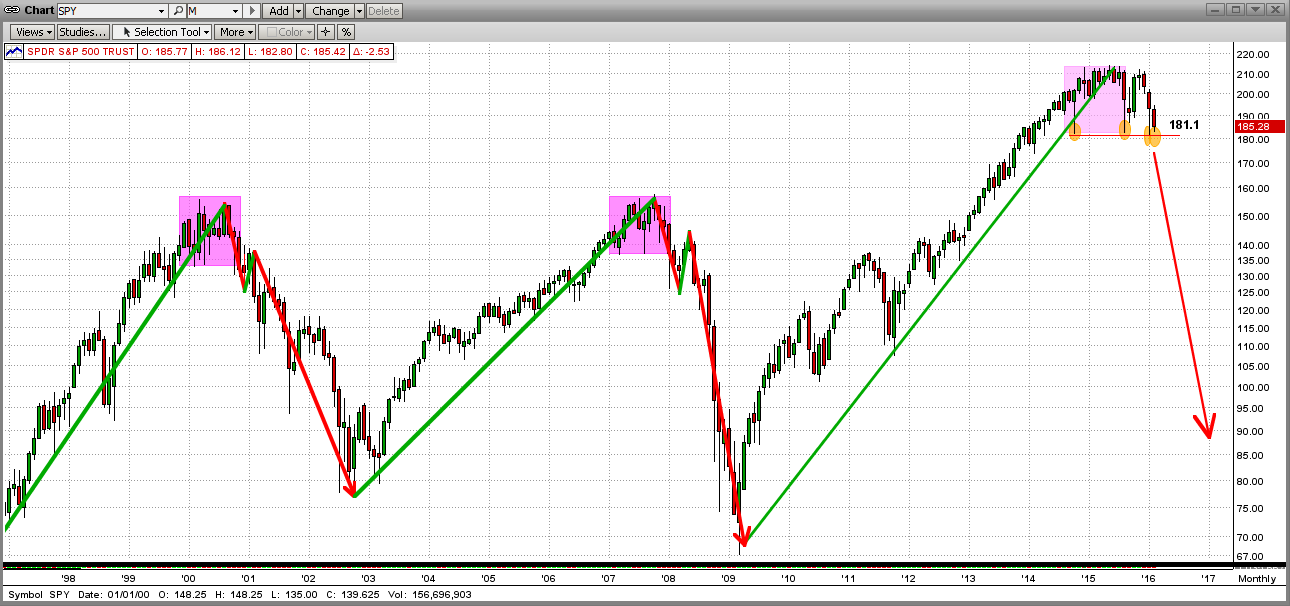
Stay tuned !!!
Friday, January 29 2016
We may have unravelled the "Big Guys" selling plan !!!
- (where by may have I mean likely, but not absolute)
All we really had to do to unfold this was to follow "The Bear" on 3 trips toward its goal:
1) thru the daily path,
2) thru the weekly path, and
3) thru the monthly path.
The Bear left very clear prints of where it had been and pointed out to us where it is most likely going. We don't need much of an explanation here, as the graphs below speak for themselves. Remember, the market moves in cycles and hits resistance and support levels along the way. For example, as a market travels a long way through an entire Bear market, it will meet (and need to break through) many support levels along the way. And, the support levels get harder to break through the further down they are.
So far, in the last 12 months the market has waffled back and forth for a record number of times for any prior 12-month period in market history, and has started what appears to be a big market drop. It could be a "correction" (drop of less than 20%) or a full-out "market crash" (i.e., a drop greater than 20%, and as far down as 40-60%).
The graphs below are:
Graph #1 - Daily graph,
Graph #2 - Weekly graph, and
Graph #3 - Monthly graph.
From its path in Graph #1 below, you will see that the S&P 500 (as represented by the ETF SPY), experienced an all-time high in May 2015 at 210.4 (about 2140 on the SP500 index) and has since broken key support levels on the way down at 204.0 202.0 200.0 187.0 182.0 and then it failed to break and stay below 181.0. In fact, the SPY failed to break and stay below 181.0 three times in the last 15 months (10/15/2014, 8/24/2015, and 1/20/2016).
Of course, this "Bear Path" is the work of the big guys. They try to hide their selling, but good technical analysis can expose them. The fat kats use volatility to try to "hide" their path; but again, good technical analysis can expose them. First we must make some sense out of the daily movements, and then the story gets more and more understandable as we move from the highly volatile daily graphs to the smoother, less distracting weekly and monthly graphs. In actuality, when we get to monthly graphs, the story is very obvious, clear, and telling.
In the past when similar patterns happened, the market has gone into full-fledged market crashes. Of course, that is just my personal analysis. But, MIPS is greatly different and is much more comprehensive. In addition to this type of analysis, MIPS uses other, much more comprehensive and reliable ways of determining which way the market is headed.
So, stay tuned and let MIPS guide us until the present plan runs its course.
- BTW, don't fear the Bear, as MIPS will take us short and we will greatly benefit from the market's
demise.
Graph #1 - Daily graph
See the 181.0 support levels at 10/15/2014, 8/24/2015 and 1/20/2016
- pink ellipses in the graph below
What I see here is strong support at 181.0
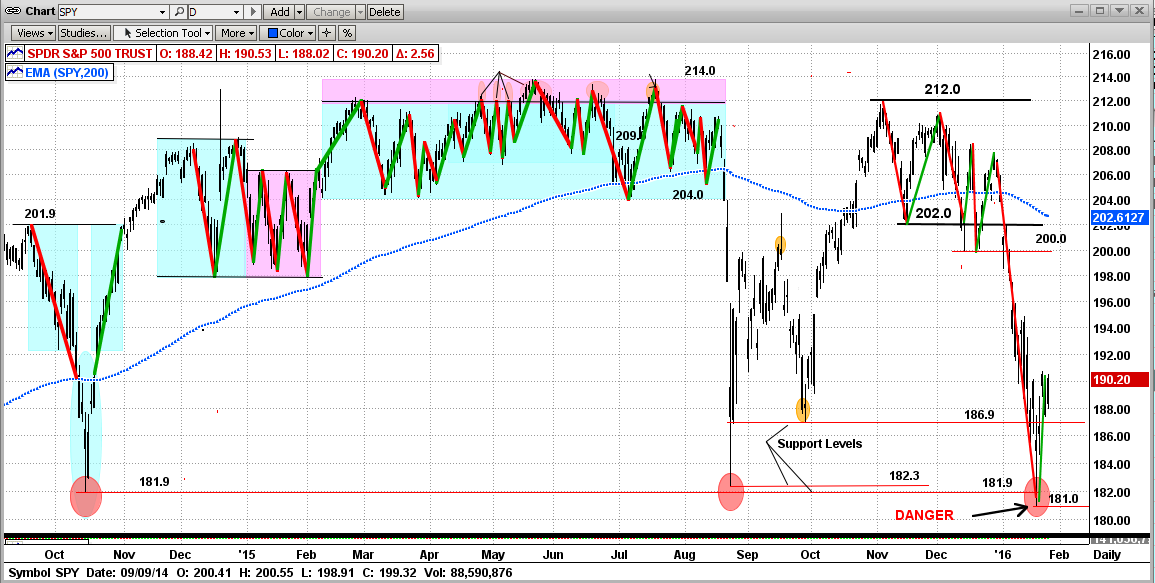
Graph #2 - Weekly graph
See the 181.0 support levels at 10/15/2014, 8/24/2015 and 1/20/2016
- pink ellipses in the graph below
What I see here is a broken trend and several strong attempts to crash (all failed at 181.0)
(Double Top ???)
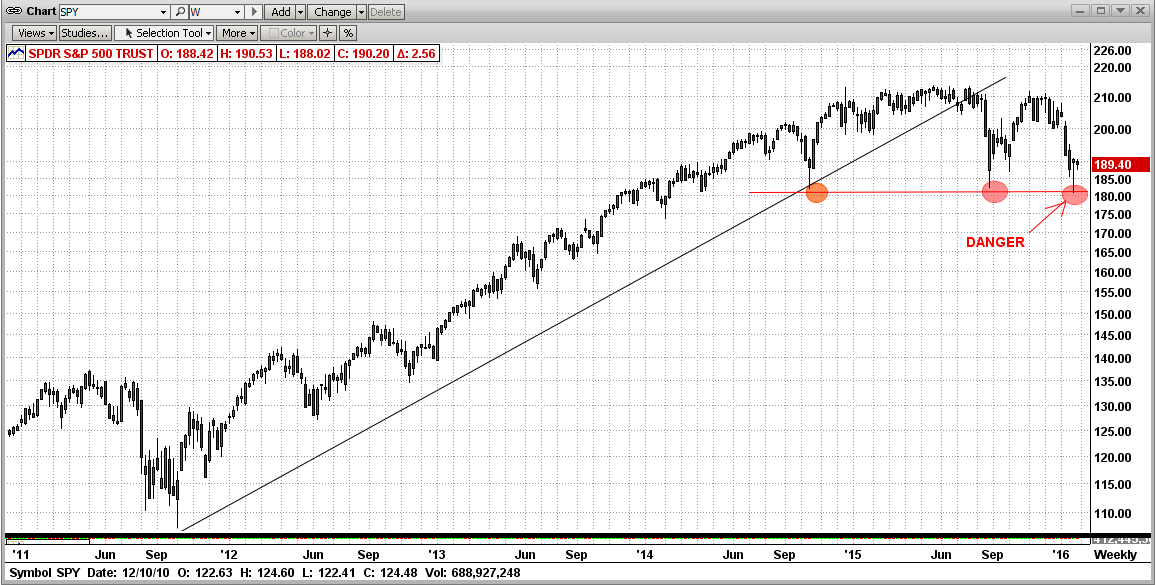
Graph #3 - Monthly graph
See the 181.0 support levels at 10/15/2014, 8/24/2015 and 1/20/2016
- pink ellipses in the graph below
What I see here is a "topping" process that has run its course, with three attempts to break down hard, as in 2000 and 2008.
(Isn't it amazing that the volatility and waffling in all of Graph #1 is in the last three monthly bars below?)
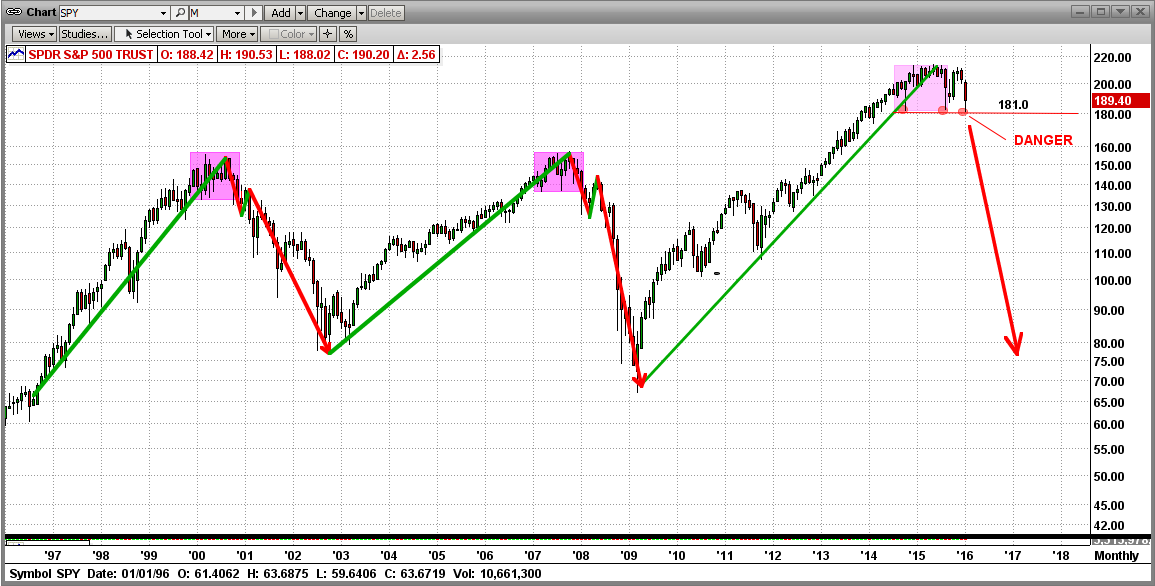
Good trading !!!
Monday, January 18 2016
Is the Bear Upon Us?
We are smothered with "data and opinions" every day now that prove the market is heading for big trouble. This bad news is now centered around things like China's slowing economy and failing stock market (yes failing, not just falling); bad U.S. numbers on manufacturing output and retail buying; falling oil prices; fear that the Fed will reverse its course and start QE again, etc. Even if we knew for sure that all of this reported data was accurate, we would still not be able to figure out the impact on the stock market.
So, what good is this data if it cannot help us decide how it will affect the market. I am not sure about that, but I do think that there is an "indirect" way we can participate in the correct market moves. Institutional investors like Goldman Sachs, Morgan Stanley, UBS, etc. (the "fat kats") all have large staffs of hundreds of "Analysts" that analyze this data for them. Please understand that whatever actions the fat kats implement from their Analysts' recommendations are almost always 100% accurate, if you measure "accurate" by whether or not the market moves the way the analysts said it would. Well folks, if the fat kats buy, the market goes up whether or not it should; and if the fat kats sell, the market goes down whether or not if should. In other words, the price action of the market "follows the money".
This is not because the fat kats know which way the market should be going, it's because the market moves the way the fat kats push it (fat kats buying leads to up markets, and fat kats selling leads to market drops).
So, since we cannot predict the way the market will move, we seek to identify the way the fat kats are trading (buying or selling) and mimic them. MIPS capitalizes on this the by using "volume weighted data", where price action on high volume has a greater impact on the MIPS models than price action on lower volume.
[About a month ago we wrote a blog entitled "Is the Market Topping?" This was about how the fat kats "dump" their positions when the market is "topping" (i.e., turning from a bull market to a bear market). See http://www.mipstiming.com/blog/view/8682/is_the_market_topping_]
We actually thought that there was a good chance that the market was topping then, and we think so even more now. In the graph below, you can see that we have recently ALMOST completed this latest topping cycle, like the cycles from the start of previous Bear Markets (in 2000 and 2008); including two drops below the SPY's 200-day EMA (where "ALMOST" is explained below this graph).
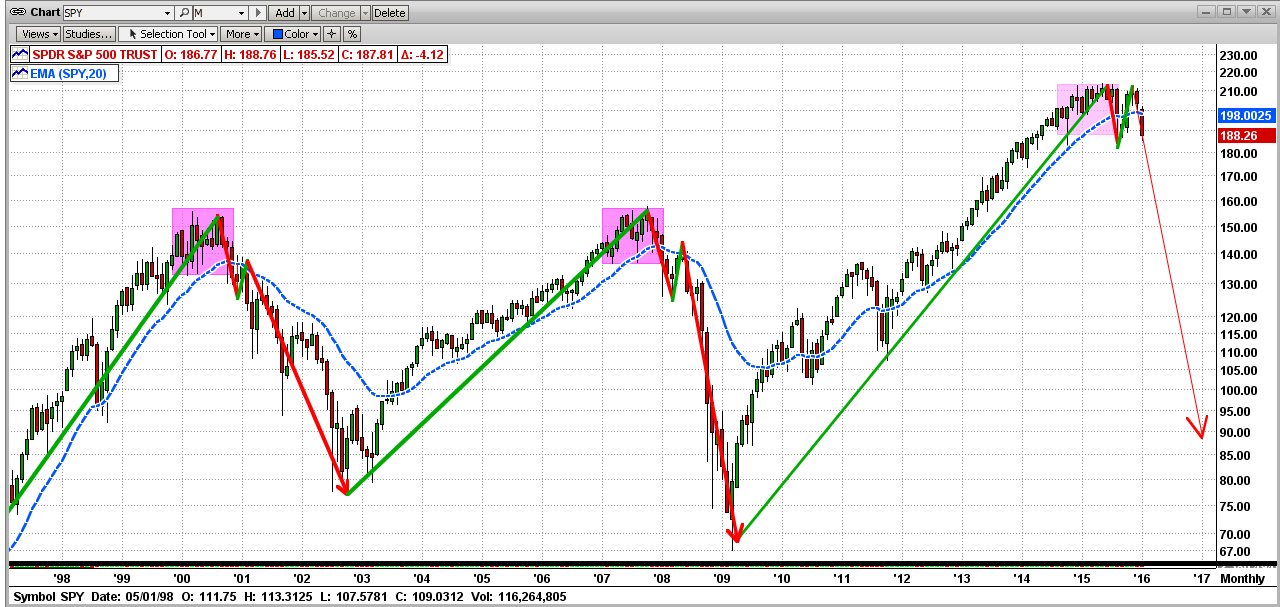
"ALMOST"
I used the word "Almost" above because there are a couple of things that have to happen before I would "bet-the-farm" on the big crash starting now !!!
The main requirement for the big crash to happen soon is that the SPY has to break through several more very strong "Support Levels" (see graph below). As you can see, so far the SPY has broken support levels at 202.0 on 1/04/16, and 199.9 on 1/06/16. Then the SPY dropped all the way down below the even stronger support at 186.9 on 1/15/16 (Friday), but closed above that level at day end. That could signal a reversal.
To turn into a market crash, the SPY still needs to break through strong resistance at 186.9 and 182.36 and finally at 181.9. Seems like quite a task, but the lower support level at 181.9 is only about 3% from Friday's close. Even if this all happens in the next few days/weeks, the bulls could still want this market to "top" for several more months before giving in to the bears.
BTW: MIPS3 and MIPS4 went to cash on 12/30/15, and short on 1/08/16...
Stay tuned...
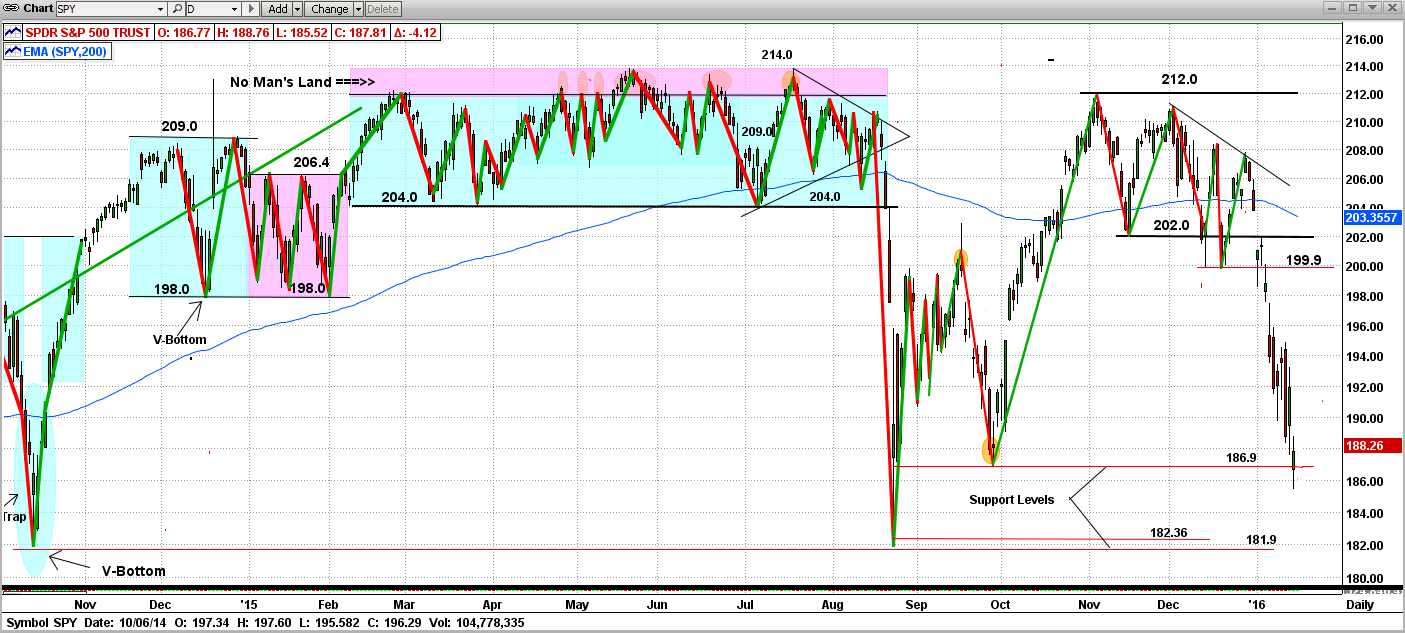
|